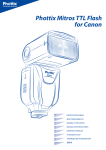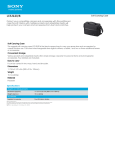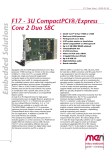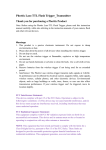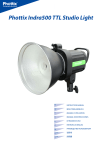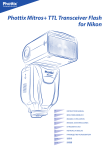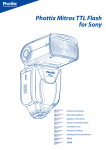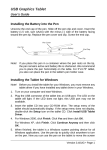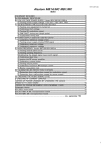Download Phottix Mitros Flash Head
Transcript
s h i v v e r m a | p h o t o g r a p h y Product Reviews P HOTTIX MIT R OS T T L FLA S H HEA D Copyright © 2013 Shiv Verma. All rights reserved. 6 5 2 d e d h a m s t r e e t , w r e n t h a m , m a 0 2 0 9 3 - 11 4 9 • t e l e p h o n e : 6 1 7 . 7 5 9 . 0 0 1 0 • f a x : 7 7 4 . 3 0 0 . 8 0 4 3 • w w w. s h i v v e r m a . c o m Phottix Phottix (Hong Kong) Ltd. is a Honkg Kong based company specializing in photography accessories. In addition to their headquarters in Hong Kong, they have offices in Germany and Poland. The company provides a plethora of photographic accessories form remote shutter releases, flash triggers, and studio accessories, to the innovative and US patent pending Phottix Odin TTL Trigger and Strato Series wireless trigger systems. In addition they provide flash diffusers, rechargeable batteries, battery grips, cables, UV filters, lens caps, tripods, ball-heads and other accessories. Disclaimer Trademarks All products mention in this review are trademarks or registered trademarks of the respective manufacturers. All product names identified throughout this review are used in editorial fashion only and for the benefit of such companies with no intention of infringement of the trademark. 2 Review of the Phottix Mitros TTL Flash October 2013 The Mitros was released in March 2013 as a competitor to the Canon 600-EX. In my opinion it actually falls between the 580-EX II and 600-EX. As far as hot shoe flash units are concerned there are no unique new features but it is a well constructed quality product and a very strong competitor What’s in the box: • Mitros hot shoe flash head and its carrying case • Tabletop/tripod stand • USB cable updates • 3.5mm to 3.5 mm cable to trigger the unit with a wireless receiver • Battery port adaptor • Diffuser • USB flash drive that contains the user manual • Quick start guide mountable for firmware When you unpack the unit you immediately realize that the unit is well constructed. It feels solid. The on off switch and buttons are well spaced and easy to manipulate. The four-way controller as well as the other buttons are tactile, well made and ergonomic. 3 Technical specifications: • Guide No.: 58/190 (at 105mm focal length, ISO 100 in meters/feet) • Flash coverage: 24-105mm (14mm with wide angle diffuser panel) • Auto zoom (Flash coverage automatically adjusts to match the lens focal length) • Manual zoom (Zoom can be adjusted by changing setting on the flash/camera) • Rotation: 360 degrees, Up-Down: -7 to 90 degrees. • FEC (Flash exposure compensation): Manual • FEB (Flash exposure bracketing): ±3 stops in 1/3 stop increments (Manual flash exposure compensation and FEB can be combined) • Sync modes: First Curtain Sync, Second Curtain Sync, and High Speed Sync • Stroboscopic flash: 1-199Hz • Flash exposure confirmation: Blue LED lamp lights up in E-TTL mode • Flash Recycling (with size-AA alkaline batteries) • Recycling time/Flash-ready indicator: • Normal flash: Approx.0.1-5 sec./Red LED indicator lamp lights up. • Quick flash: Approx.0.1-2.5 sec./Green LED indicator lamp lights up. • Internal power: Four size-AA alkaline batteries or size-AA Ni-MH batteries • External battery: Compatible with Phottix Battery Pack and Canon compact battery pack CP-E4 through specific adapter • Power saving: Non-wireless slave modes: 90 seconds, Wireless slave mode: 60 minutes • Wireless flash • Transmission method: Optical pulse • Channels: 4 • Wireless options: OFF, Master, Slave and Optical Slave • Transmission range (Approx.): ( Indoors:12-16m/39.36-52.48 ft., Outdoors: 7-9m/ 22.96-29.52 ft. Reception angle: ±40°(horizontal),±30°(vertical) • Controlled slave groups: 3 (A, B, and C) • Flash ratio control: 1:8-1:1-8:1 • Standby current: ≤100uA in sleep mode • Dimensions: (L x W x H): 202.8×77.5×58.3 mm • Weight: 427g (excluding batteries). 4 Views of the unit: The flash head is larger than the canon 580 EX II. Provide are a pop out bounce panel and a wide-angle light spreader/diffuser panel that is a snap-on. The head has no rotation interlocks nor does it have interlock for head angle. for head rotation and head angles. As a result, any of the heavier light modifiers when attached cause the head to flop. The flash front has an IR sensor for slave functionality On the side are rubber sealed doors that provide access to the eternal power adaptor socket, the USB port and the 3.5mm socket. The back of the unit (the side facing you when mounted has the control panel comprised of an LCD window; the on/off switch; a four way control that configures the unit for master or slave, zoom, high speed sync, and sets the custom functions, and the central button to “Set” or confirm; a test button and a ready indicator. The battery compartment has a strange layout for 4 AA batteries. One gets used to this in a few changes. The flash head will rotate 360 degrees and will tilt from a -7 degree to a 90 degree orientation marked at 45, 60 and 75 degrees. Ease of Use A great feature is the need to depress and hold the “mode” button to take the unit out of R-TTL mode. This will prevent any accidental switching of modes. Even though there are no positive locks the head is easy to position and without any light modifiers installed it remains in place where positioned. 5 The four way controller functions as follows: • • • • Up Arrow / Zoom Adjustment Mode Button Right Arrow / Wireless Flash Mode Button Down Arrow / HSS / SCS Button Left Button / Custom Functions Button Flash Modes The Phottix Mitros has three flash modes: ETTL, Manual (M) and Multi (Stroboscopic). Pressing the Mode button cycles through the these modes. Flash exposure compensation and bracketing are standard. The Mitros operates absolutely flawlessly in the E-TTL mode. Manual (M) Mode In Manual Mode the flash can be adjusted from 1/1 (full power) to 1/128 – providing 8 stops of adjustment in 1/3rd stop increments. Multi: Stroboscopic Mode With Multi Stroboscopic mode a series of rapid flashes are fired. The flash count, frequency and power of these flashes can be programmed on the unit. Flash Zoom The unit has two flash head zoom modes – Auto (Azoom) and Manual (Mzoom). In Auto zoom the unit will automatically zoom as the lens zoom is changed. In Manual zoom you set the zoom from 24 to 105 mm. High Speed Sync or Second Curtain Sync The flash has both High Speed Sync and Second Curtain Sync functions. These are set using the bottom button on the four way controller. High speed and second curtain sync do not operate in Multi Mode. Modeling Flash The unit’s modeling flash will fire each time the camera’s depth-offield preview button is depressed and will fire for 1 second. A convenient feature for studio work. 6 Adjustments The unit can be adjusted in 1/3 stop increments and will automatically switch to 1/2 stop increments if the camera has been set for 1/2 stop adjustments. Wireless Triggering Mode The Mitros can be triggered as an Optical Slave (OS) and the configuration is similar to the Canon flash set-up. To fire the Mitros as slaves, a master unit must be used. This can be a oncamera pop-up featured on most prosumer and consumer Canon bodies or another Mitros. For non optical wireless triggering the Phottix Odin Master and Slave units allow for true radio frequency based wireless control. In Optical Slave (OS) Mode the unit will operate in the manual mode based on the settings for power output. In Master mode the unit can be set to Master with flash firing or without flash. While setting the unit for Master or Slave operation you can also set the channels and groups. Transmission channels The Phottix Mitros Wireless system has four transmission channels: 1, 2, 3 and 4. and 3 Groups A, B and C. Using Wireless Triggering Set one flash unit to Master mode and mount it on camera, set remote flashes to Slave mode. Now pressing the shutter button fires the Master flash (if set to Master with flash) and fwill trigger the slaves that are within line of sight and within the range of the Master flash. The camera and flash will meter the scene and fire flashes in TTL mode to properly expose the scene. Ratio Modes Slave flashes can be controlled by the master flash in different ratio modes. The following tests were conducted: The Mitros was tested as a single on/off camera flash (using a off camera flash cord) with a Canon 5D Mk III. One Mitros was set as the master (no flash), one flash on a stand as the Key light and one as a fill light. 7 One Mitros as a Key, one as a fill and one as a hair light. A Canon 7D popup flash was used as the master. The last test was conducted with the Odin system. One maser unit mounted on a Canon 5D Mk III, and three Mitros units each on a Odin receiver. The units were set up in groups. Three heads were used and set as group A, B and C all on one channel. The Odin wireless trigger system was used to control the heads. This was my most favored configuration. With this configuration you can see and adjust the various groups individually or as a set and control the ratio without the need to step up to a single unit. Pros and Cons Pros • Powerful Flash output • ETTL and High Speed Synch capability • Intuitive interface • Excellent compatibility with the Odin Wireless System • Good diffuser bundled with the unit • Excellent build quality Cons • No Head rotation and angle interlocks • No internal receiver compatible with the Odin system • Not critical but a con - No PC sync port The Mitros is an excellent speed light and a bargain compared to similar power and function packed units.The Odin TTL transmitter/receiver compatibility is excellent. The Mitros may not be better than the Canon 600-EX RT system but it is close. If you compare the price, this flash can’t be beat. 8








